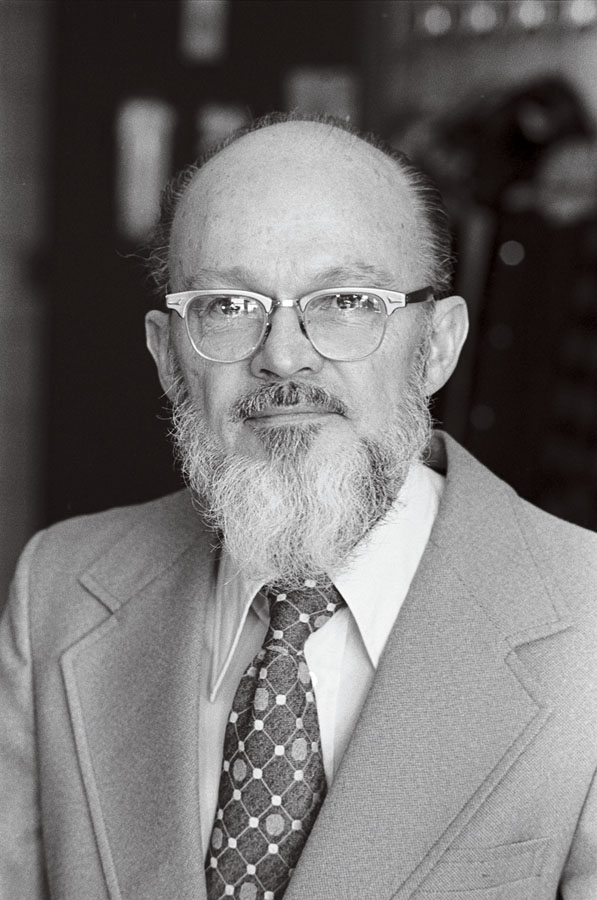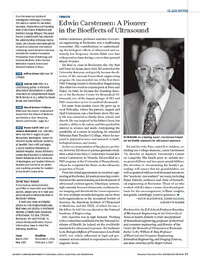Class Notes
 IN DEMAND: As a leading expert, Carstensen helped set worldwide standards for ultrasound exposure. (Photo: University Libraries/Department of Rare Books, Special Collections, and Preservation)
IN DEMAND: As a leading expert, Carstensen helped set worldwide standards for ultrasound exposure. (Photo: University Libraries/Department of Rare Books, Special Collections, and Preservation)Edwin Carstensen, professor emeritus of electrical engineering at Rochester, was a trailblazing researcher. His contributions to understanding the biological effects of ultrasound and extremely low frequency electric fields won him widespread acclaim during a career that spanned almost 50 years.
Ed died in June in Rochester, the city that had been his home since 1961. Ed arrived at the University that year, and quickly became the director of the nascent biomedical engineering program. He was awarded one of the first three NIH Training Grants in Biomedical Engineering (the other two went to counterparts at Penn and Duke). In 1986, he became the founding director of the Rochester Center for Biomedical Ultrasound, one of the largest groups of MD and PhD researchers active in medical ultrasound.
Ed came from modest roots. He grew up in rural Nebraska, where his parents, August and Opal Carstensen, ran a hardware store. His early life was centered on family, farm, school, and church. He was inspired by his father’s keen, but intuitive, ability to fix radios, and this sparked his interest in science and math. Anticipating the possibility of a career in teaching, he attended Nebraska State Teacher’s College, where he majored in physical science and minored in math, biological science, and music.
At the recommendation of his physics professor, however, Ed chose to pursue graduate study. After a stint at the Navy’s Underwater Sound Reference Laboratory in Orlando, Ed enrolled in a PhD program at the University of Pennsylvania, where he completed his thesis on the ultrasonic properties of blood.
From his initial appointment in electrical engineering at Rochester, Ed made pioneering contributions to the understanding and development of ultrasound contrast agents, lithotripsy systems, high intensity focused ultrasound, nonlinear tissue imaging, and thresholds for tissue exposures. He won multiple awards during his career from such organizations as the Acoustical Society of America, the American Institute of Ultrasound in Medicine, and the IEEE, of which he was a life fellow. In 1987, he was elected to the National Academy of Engineering.
Ed’s expertise was in high demand. Working with a committee established by the National Institutes of Health, he helped set the worldwide standards for ultrasound exposure. His landmark book, Biological Effects of Transmission Line Fields (1987), was widely influential in legal and government actions related to exposures to electromagnetic fields.
Ed and his wife, Pam, raised five children, including one College alumnus, Laura Carstensen ’78, director of Stanford University’s Center on Longevity. His family grew to include seven grandchildren and two great-grandchildren. His devotion to documenting his family’s genealogy will ensure that his grandchildren are well acquainted with several thousand ancestors. His “academic descendants” are many, including Diane Dalecki, professor and chair of biomedical engineering at Rochester. Those of us who worked with Ed share a sense of profound gratitude for his encouragement, brilliant insights, and gentle, unfailingly positive guidance.
—David Blackstock, Diane Dalecki, and Kevin Parker
Blackstock is the E. P. Schoch Professor Emeritus of Mechanical Engineering at the University of Texas at Austin. Dalecki is chair and professor of biomedical engineering, professor of electrical and computer engineering, and director of the Center for Biomedical Ultrasound at Rochester. Parker is the William F. May Professor of Electrical and Computer Engineering, Biomedical Engineering, and Imaging Sciences, and dean emeritus of the Hajim School.

